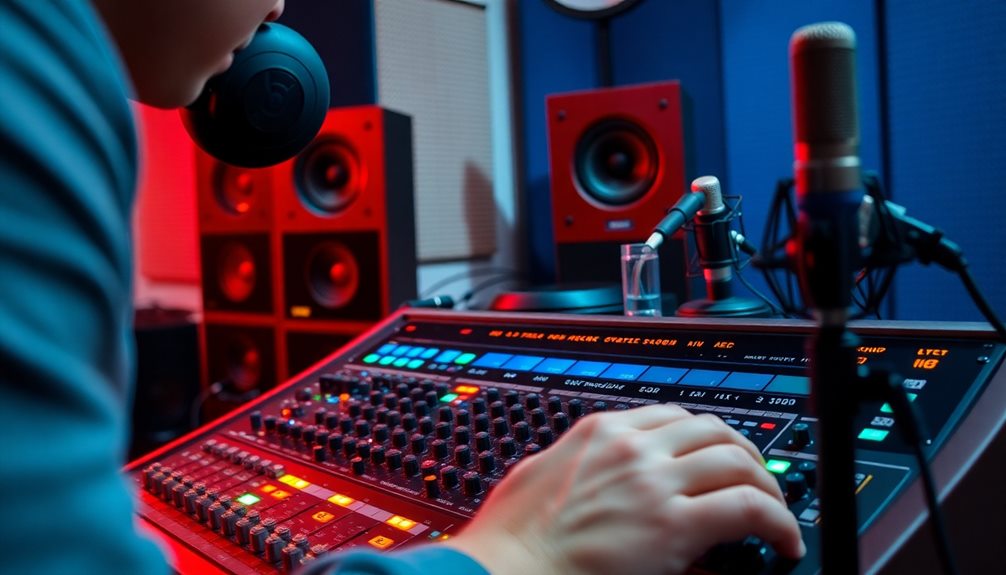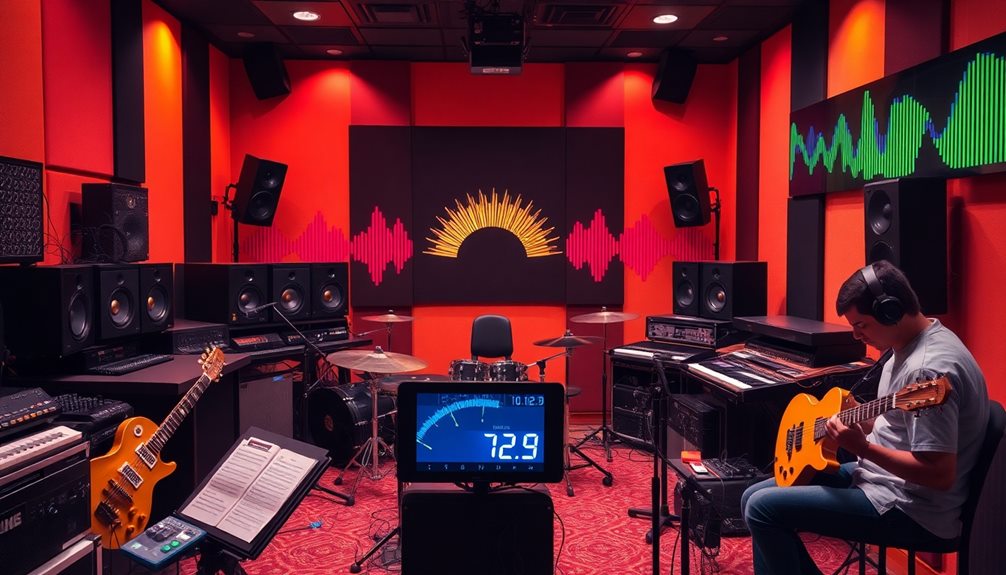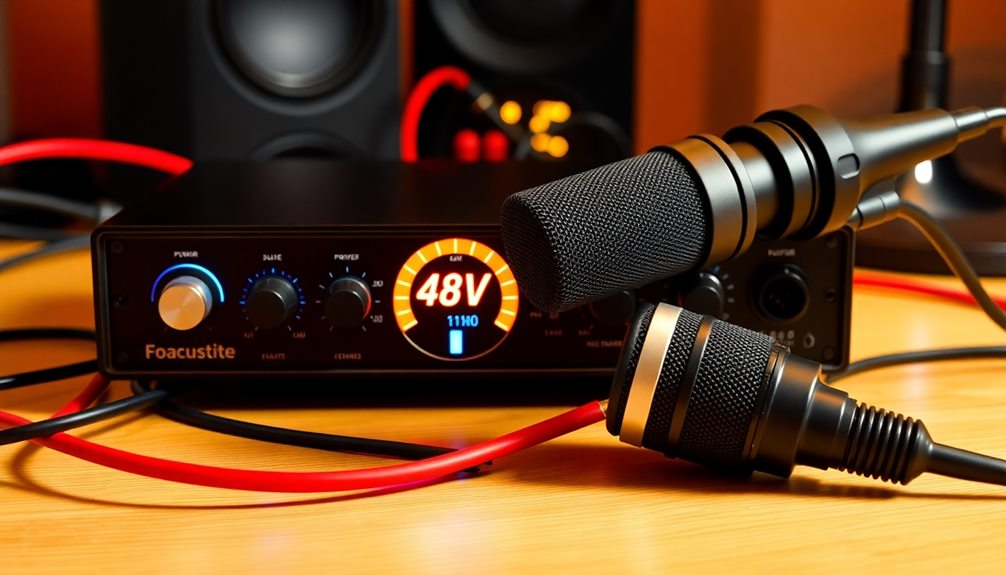Decibels, or dB, are super important for audio engineers like you! They measure sound intensity, helping you understand how loud or soft a sound is. The dB scale is special because every 10 dB jump means ten times more intensity. For example, a whisper is about 30 dB, while a jet engine reaches over 120 dB. Knowing these levels helps you mix sound clearly without distortion. If you're mixing, aim for 79 to 83 dB for the best results. Understanding dB can make your audio shine and keep listeners safe, so there's much more to discover!
Key Takeaways
- Decibels (dB) measure sound intensity, with 0 dB SPL representing the threshold of human hearing at 20 µPa.
- The logarithmic dB scale indicates that a 3 dB change doubles or halves sound intensity, crucial for audio mixing.
- Effective audio levels are typically maintained between 79-83 dB SPL to ensure clarity and minimize distortion in recordings.
- Understanding A-weighting helps tailor sound measurements to human hearing sensitivity, enhancing audio quality in productions.
- A high Signal-to-Noise Ratio (SNR) of 60 dB or more is essential for clear signals, preventing clipping in recordings.
Understanding Decibels
When you think about sound, decibels (dB) are essential for understanding how we perceive intensity. They help you grasp the loudness of sounds around you.
Decibels are measured on a logarithmic scale, which means that every increase of 10 dB makes a sound ten times more intense! For example, a whisper is about 20 dB, while a jet engine at takeoff reaches around 120 dB. That's a huge difference!
The reference value for measuring sound pressure levels is 20 µPa, which represents the lowest sound you can hear—your threshold of human hearing.
Audio engineers use decibel calculations to determine how loud a sound is compared to that reference. So, when you're listening to music or watching a movie, those decibels give you a sense of how intense each sound is.
Understanding the noise levels around you can help protect your hearing too. Sounds above 85 dB can be damaging.
The Db Scale Explained

The dB scale is a cool way to measure sound that makes it easier to understand loudness.
It's not a straight line; instead, it's logarithmic, meaning each step up makes sound ten times louder!
Let's explore how this scale works and where you'll see it in action, like in music and everyday sounds.
Logarithmic Measurement System
Understanding the dB scale is essential for audio engineers, as it provides a practical way to handle the vast range of sound intensities we encounter. The decibel (dB) scale is a logarithmic measurement system, which means it helps us express huge differences in sound intensity and power in a simpler way.
For instance, a 10 dB increase means the sound intensity has increased tenfold! That's powerful!
When you measure sound pressure levels (SPL), you use the formula 20 log (P2 / P1). For power measurements, it's 10 log (P2 / P1). The reference levels are also important. Did you know that 0 dB SPL is the threshold of human hearing? That's where we start to hear sounds at 20 µPa!
This logarithmic scale shows that even small changes can make a big difference. A 3 dB change can double or halve the sound intensity you perceive.
Common Db Applications
In audio engineering, the decibel scale finds numerous applications that help you gauge sound intensity effectively. Understanding common sound levels is super important! For instance, a decibel value of 20 dB is as quiet as a whisper, while a loud conversation registers around 60 dB.
Now, imagine a jet engine at takeoff—it's an ear-piercing 120 dB! This wide range illustrates how our ears perceive different sounds.
The decibel scale has a reference sound; specifically, 0 dB SPL is the faintest sound we can hear. This standard helps you compare other sounds easily.
When working with digital audio, you'll encounter 0 dBFS, which is the max signal level before distortion occurs.
You might also hear about A-weighted decibel levels, or dB(A). These adjust measurements to fit how our ears respond to various frequencies, making them perfect for checking noise in the environment.
Reference Levels in Db
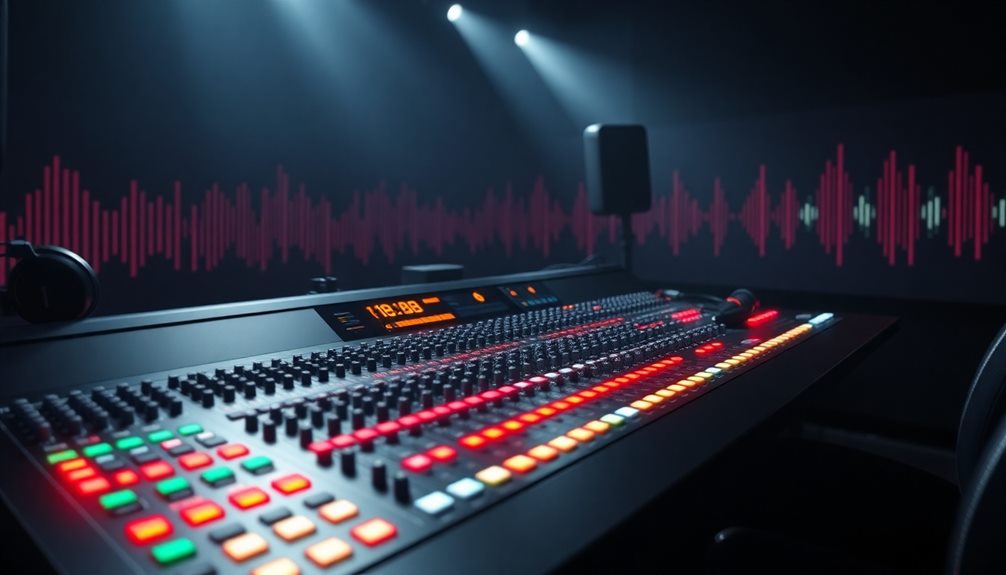
How do reference levels in decibels (dB) shape your understanding of sound measurements? These levels are super essential! They help you measure sound accurately and understand its intensity. For instance, the common reference for Sound Pressure Level (SPL) is set at 20 µPa, which is the softest sound humans can hear. This gives you a baseline to compare all sounds.
Here's a quick look at some common reference levels:
| Measurement Type | Reference Level |
|---|---|
| SPL | 20 µPa (threshold of hearing) |
| dBu | 0.775 volts RMS |
| dBm | 1 milliwatt |
| dB (sound) | Relative to SPL |
Using these references makes communication clearer. If you don't specify the reference, it can lead to confusion. Understanding how to measure sound using decibels helps you achieve better clarity in your audio work. So, when you think of power levels or sound intensity, remember how essential these reference levels are. They're the key to mastering sound!
Common Db Measurements
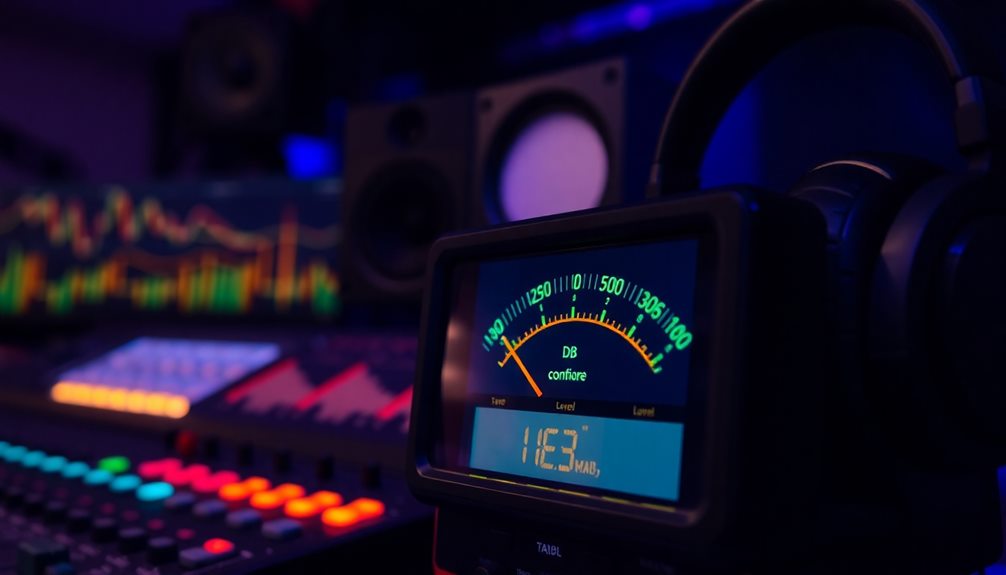
Decibels (dB) serve as an essential tool for measuring sound levels in various environments. When you're measuring the sound pressure levels (SPL), you'll notice that 0 dB SPL is the softest sound your ears can hear, which is just 20 µPa! A whisper is around 30 dB, while a normal conversation sits between 60 to 70 dB. Sounds above 120 dB can hurt your ears and even cause damage!
Understanding decibels is vital because the dB scale is logarithmic. This means that every 10 dB increase is ten times more intense! So, 90 dB sounds much louder than 80 dB.
In audio work, levels of 79 to 83 dB SPL are common and recommended for mixing. This helps keep your sound clear and avoids distortion when you play it back.
In digital audio systems, dynamic ranges can reach up to 144 dB, which is super impressive! This allows for a wide variety of sounds without losing quality.
Applications of Decibels
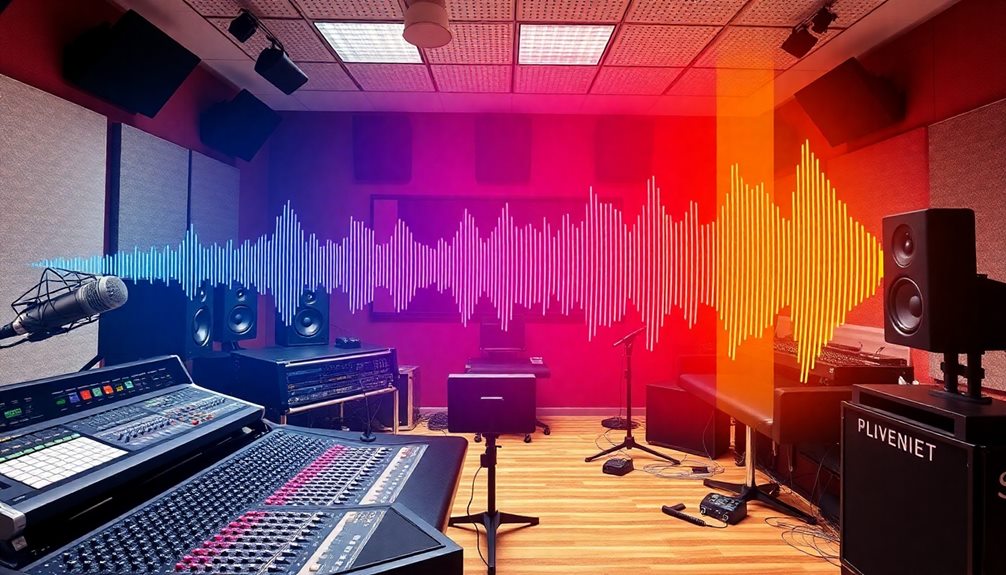
Understanding the applications of decibels (dB) is essential for anyone working in audio. Decibels are always a key factor in measuring sound pressure levels (SPL). For instance, 0 dB SPL marks the quietest sound you can hear!
When mixing and mastering audio, you'll notice that a 10 dB increase means the sound feels twice as loud. This is super important for creating balanced tracks.
In workplaces, decibels help keep you safe. Sound exposure levels expressed in dB show how loud is too loud, preventing hearing damage.
You'll also find decibels used to evaluate audio equipment. For example, a 3 dB gain indicates a doubling of power output. That's a big deal!
In the world of digital audio, you'll encounter the concept of dBFS, which tells you how close you're to the maximum level. If you go above 0 dBFS, you risk clipping, which can ruin your audio quality.
Myths About Decibels

Many audio professionals fall prey to common myths about decibels that can lead to misunderstandings in their work. Understanding the truth can make your audio journey smoother and more enjoyable. Here are some myths to watch out for:
- 10 dB equals twice as loud: A 10 dB increase typically means a tenfold rise in sound intensity, not a doubling of perceived loudness. You need about a 10 dB jump for that.
- Negative dB means silence: Not true! Negative dB values show sound levels lower than the reference point, like sounds below 0 dB, which the human ear can hear.
- Decibels have fixed limits: Decibel measurements can stretch infinitely in both directions. They're not restricted to a specific range.
- Everyone hears the same: Perceived loudness varies from person to person. Just because it's measured in dB doesn't mean everyone experiences it the same way.
Decibels in Digital Audio
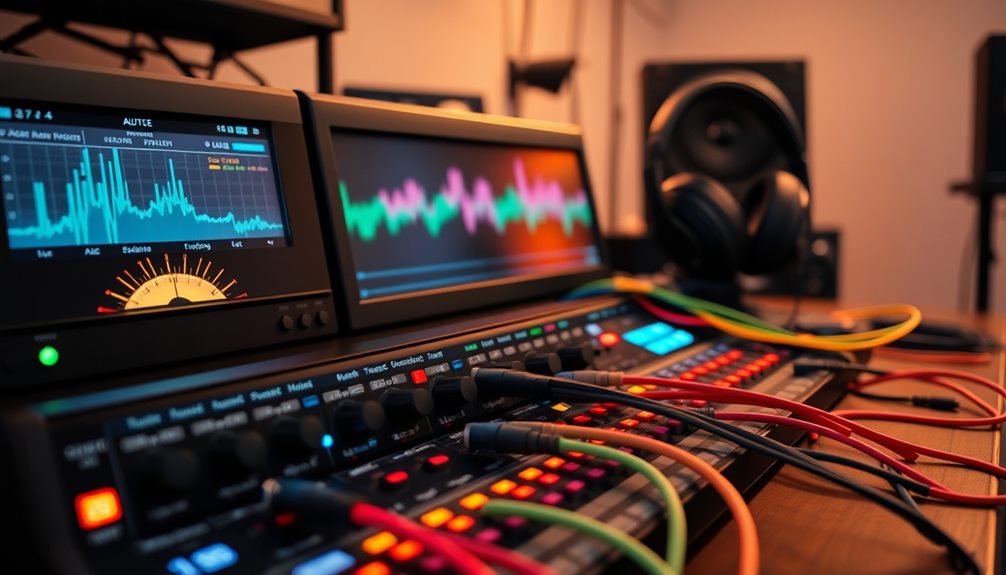
In digital audio, managing levels is essential to achieving high-quality sound. You want to avoid going over 0 dBFS, which stands for decibels relative to full scale. If you exceed this point, you risk signal distortion that can ruin your recordings. Think of it like overflowing a glass of water—once it spills, you can't take it back!
A 16-bit system typically offers a dynamic range of 96 dB. If you're using a 24-bit system, you can get an even wider dynamic range of 144 dB! This means you can capture both soft and loud sounds more clearly.
Don't forget about the noise floor, too. This is the quietest sound your system can capture, and it's crucial for keeping your recordings clean.
When mixing and mastering, understanding decibel levels helps you balance everything just right. You want your music to sound full and rich without any unwanted noise or distortion.
Importance of Db for Engineers

Understanding dB is super important for you as an audio engineer!
It helps you manage sound levels effectively, ensuring everything sounds clear and balanced.
Plus, knowing how to work with dB lets you keep the integrity of your audio, making your recordings and live performances truly shine!
Signal Clarity and Integrity
Decibels (dB) are vital for audio engineers aiming to enhance signal clarity and integrity. By using dB, you can make certain your audio systems perform at their best. Here are four reasons why dB matters:
- Sound Level Measurement: dB helps you measure sound levels accurately, allowing for standardized comparisons.
- Power Level Understanding: A 3 dB increase means double the power, making it easier to calibrate your audio systems and avoid distortion.
- Signal-to-Noise Ratio (SNR): Maintaining a high SNR, ideally 60 dB or more, is essential for keeping your signals clear and free from unwanted noise.
- Dynamic Range: Knowing the dynamic range, which can reach up to 144 dB in 24-bit digital systems, guarantees your audio stays clear and doesn't clip or distort, even at varying volumes.
When you incorporate A-weighting in your dB measurements, you're tuning your audio for human hearing sensitivity.
This means you can monitor and adjust levels in a way that reflects how we actually perceive sound. By focusing on these aspects, you can achieve remarkable signal clarity and integrity in your audio work!
Effective Sound Level Management
Effective sound level management is essential for audio engineers who want to deliver high-quality audio without distortion. Understanding decibels (dB) helps you measure sound pressure levels accurately. At 0 dB SPL, you're at the faintest sound detectable by the human ear, which is a level of 20 micro-Pascals.
It's exciting to realize that a mere 3 dB increase doubles the sound intensity!
When mixing levels, aim for 79 to 83 dB SPL for clear, crisp audio. This range helps you avoid distortion and keeps your tracks sounding great. Remember, dB works on a logarithmic scale. This means small changes can have a big impact!
If you're working with digital audio systems, such as 24-bit systems, you'll need to be aware of dBFS (decibels relative to full scale). Exceeding 0 dBFS can lead to signal loss and ruin your audio fidelity.
Frequently Asked Questions
What Is Db in Sound Engineering?
In sound engineering, dB measures sound intensity. You'll find it essential for comparing different sound levels, as each 10 dB increase means a tenfold increase in intensity, impacting how you adjust and calibrate audio effectively.
What Is the 3 Db Rule?
The 3 dB rule means an increase of 3 dB doubles sound intensity, while a decrease halves it. Understanding this helps you manage sound levels effectively, ensuring your audio remains balanced and perceptually consistent.
How Many Db Should My Audio Be?
To guarantee your audio sounds great, aim for mixing levels between 79 to 83 dB SPL. Imagine a lively concert; that balance keeps everything clear without overwhelming your audience—just like achieving the perfect sound in your home studio.
What Is the Unit of Noise Level Dba?
The unit dBA measures sound levels adjusted for human hearing sensitivity. It emphasizes mid-range frequencies, making it more relevant for evaluating perceived loudness. You'll find it essential for determining environmental and workplace noise levels.
Conclusion
So, you see, understanding decibels is like opening a treasure chest for audio engineers! Knowing how to measure and use dB can turn your sound from ordinary to extraordinary. It's a superpower that helps you create the best audio experience ever! Whether you're mixing music or adjusting a podcast, mastering dB will make your work shine. So, plunge into it, have fun, and let those decibels guide you to sonic greatness! Your ears will thank you!
